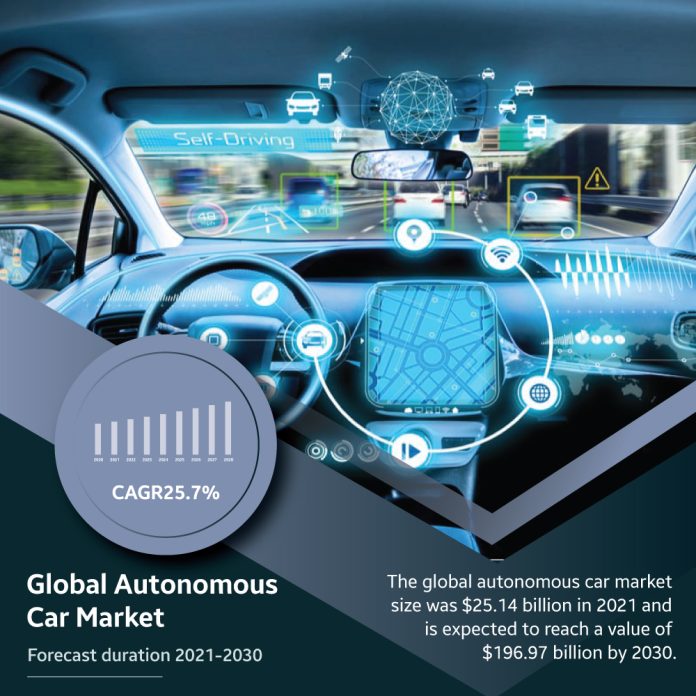An autonomous car can sense its surroundings and operate with or without human intervention, depending on its level of autonomy. Automated vehicles have sophisticated machine learning and artificial intelligence (AI) systems built in to understand their environment and obey directions. To continually update maps, detect the presence of surrounding vehicles and pedestrians, measure distances, and detect uneven surfaces in roads and sidewalks, advanced sensors and actuators are combined with cutting-edge computer vision functions.
The market worth of autonomous cars in 2021 was USD 25.14 billion, and by 2030 it will be worth USD 196.97 billion at a 25.7% CAGR during 2021-2030.
The autonomous car market will grow rapidly due to outstanding, cutting-edge facilities and customer satisfaction techniques. Additionally, consumer knowledge of the advantages of autonomous vehicles, such as their increased mobility, will increase, which will further increase demand for these vehicles. However, regulatory issues may hamper the market’s expansion. Because of the massive traffic problem, global automakers are focusing on driverless cars in order to save money and time while remaining competitive in the future.
Growth Drivers and Challenges
The adoption of autonomous cars in the world’s most populous cities, especially Los Angeles, Beijing, Tokyo, New York, and London owing to the increasing ownership of smaller homes, is boosting the market expansion. Furthermore, the industry for autonomous cars is impacted by the quick urbanization and automotive sector growth. In the United States, there is a growing tendency toward the modern lifestyle of the automobile sector among the populace, who favor inexpensive sedans, and compact cars that suit their changing lives. Additionally, the auto industry is attempting to accommodate consumers’ urban lifestyles by enhancing cars with desirable amenities. As a result, manufacturers are expanding their product lineup to include aesthetically pleasing features and offer comfortable rides to satisfy consumers’ growing expectations and support the expansion of the global autonomous car market. However, growing raw material prices, such as graphics, photographic lenses, and advanced hardware, are impeding industry expansion. Additionally, the demand for autonomous vehicles in China and the United States is being negatively impacted by the rising price of fuel.
The market for self-driving cars will grow faster in North America, Asia Pacific, and Europe. The industry in the United States and the Asia-Pacific region will be driven by population increase. In Europe, autonomous cars are gaining popularity through internet sources, leading to regional spread. However, offline channels will continue to dominate the market, while online channels will rise at a rapid pace during the projection period.
Market Segmentation
The market segments on the basis of the component are LiDAR, ultrasonic sensors, camera units, and infrared sensors. In 2021, the camera unit maintained the largest position in the market. Cameras are the most precise means to record images of the world in photographs and films, particularly for self-driving cars. Autonomous vehicles rely on cameras installed on all sides, including the front, left, back, and right, to provide a 360-degree view of their environment.
On the basis of mobility, the personal mobility market segment was the market leader and recorded the maximum revenue share in 2021. Commercial mobility is a subset of personal mobility. During the projection period, the commercial mobility segment will increase rapidly. The category of commercial mobility includes commercial operations such as ride-sharing, robot taxis, industrial transportation, and others. The introduction of robot taxis will present some new challenges for mobility as a service model or car ownership.
On the basis of vehicle type, the autonomous car market segment includes commercial and passenger vehicles. The passenger vehicle segment maintained the largest position in the global market. The substantial rise in vehicle manufacturers internationally, growing urbanization, rapid demographic expansion, improving living standards, and rising purchasing power are the key drivers of the automobile industries.
Regional Insights
North America maintained the highest market position in 2021, with 45.5% of the revenue share due to strong government support and positive consumer acceptance. The market will grow rapidly due to the launch of driverless cars in the North American market and various governments’ increased government funding to develop self-driving cars over the forecast period. According to a study, the worldwide market for self-driving vehicles will grow substantially over the next ten years due to the rapid growth of connected vehicle infrastructure over the industry’s forecast era.
Key Players
- Waymo
- Toyota
- General Motors
- Audi AG
- Tesla, Inc.
- Volkswagen
- Ford Motor Company
- General Motors Company
- BMW AG
- Daimler AG
- Volvo Car Corporation
- Honda Motor Co., Ltd.
- Google LLC
- Nxp Semiconductors
- Nissan Motor Company
- Uber Technologies, Inc.
- Ficosa International Sa
- Voxx International Corp.
- Microsemi Corporation
- Texas Instruments
The market worth of autonomous Cars in 2021 was USD 25.14 billion, and by 2030 it will be worth USD 196.97 billion at a 25.7% CAGR during 2021-2030. The increased safety provided by these vehicles is likely to propel the global autonomous car market throughout the forecast period.

